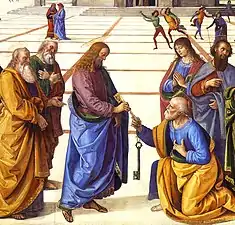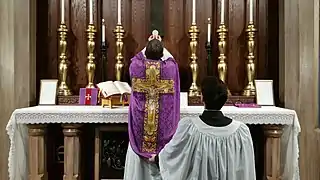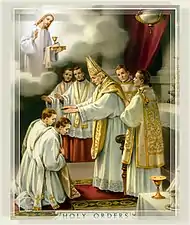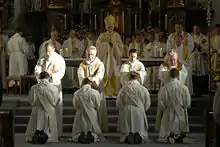Priesthood in the Catholic Church
The priesthood is one of the three holy orders of the Catholic Church, comprising the ordained priests or presbyters. The other two orders are the bishops and the deacons. Church doctrine also sometimes refers to all baptised Catholics as the "common priesthood".[1][2]
| Part of a series on the |
| Hierarchy of the Catholic Church |
|---|
 |
| Ecclesiastical titles (order of precedence) |
|
|
The church has different rules for priests in the Latin Church – the largest Catholic particular church – and in the 23 Eastern Catholic Churches. Notably, priests in the Latin Church must take a vow of celibacy, whereas most Eastern Catholic Churches permit married men to be ordained.[3] Deacons are male and usually belong to the diocesan clergy, but, unlike almost all Latin Church (Western Catholic) priests and all bishops from Eastern or Western Catholicism, they may marry as laymen before their ordination as clergy.[4] The Catholic Church teaches that when a man participates in priesthood after the Sacrament of Holy Orders, he acts in persona Christi Capitis, representing the person of Christ.[5]
Unlike usage in English, "the Latin words sacerdos and sacerdotium are used to refer in general to the ministerial priesthood shared by bishops and presbyters. The words presbyter, presbyterium and presbyteratus refer to priests in the English use of the word or presbyters."[6] According to the Annuario Pontificio 2016, as of December 31, 2014, there were 415,792 Catholic priests worldwide, including both diocesan priests and priests in the religious orders.[7] A priest of the regular clergy is commonly addressed with the title "Father" (contracted to Fr, in the Catholic and some other Christian churches).[8]
Catholics living a consecrated life or monasticism include both the ordained and unordained. Institutes of consecrated life, or monks, can be deacons, priests, bishops, or non-ordained members of a religious order. The non-ordained in these orders are not to be considered laypersons in a strict sense—they take certain vows and are not free to marry once they have made solemn profession of vows. All female religious are non-ordained; they may be sisters living to some degree of activity in a communal state, or nuns living in cloister or some other type of isolation. The male members of religious orders, whether living in monastic communities or cloistered in isolation, and who are ordained priests or deacons constitute what is called the religious or regular clergy, distinct from the diocesan or secular clergy. Those ordained priests or deacons who are not members of some sort of religious order (secular priests) most often serve as clergy to a specific church or in an office of a specific diocese or in Rome.[9]
History

Catholic priests are ordained by bishops through the sacrament of holy orders. The Catholic Church claims that Catholic bishops were ordained in an unbroken line of apostolic succession back to the Twelve Apostles depicted in the Catholic Bible. The ceremony of Eucharist, which Catholics believe can only be performed by priests, in particular derives from the story of the Last Supper, when Jesus Christ distributed bread and wine in the presence of the Twelve Apostles, in some versions of the Gospel of Luke commanding them to "do this in memory of me". (Some Protestant critics have challenged the historical accuracy of the claim of unbroken succession.[10])
Catholic tradition says the apostles in turn selected other men to succeed them as the bishops (episkopoi, Greek for "overseers") of the Christian communities, with whom were associated presbyters (presbyteroi, Greek for "elders") and deacons (diakonoi, Greek for "servants"). As communities multiplied and grew in size, the bishops appointed more and more presbyters to preside at the Eucharist in place of the bishop in the multiple communities in each region. The diaconate evolved as the liturgical assistants of the bishop and his delegate for the administration of Church funds and programmes for the poor. Today, the rank of "presbyter" is typically what one thinks of as a priest, although Church catechism considers both a bishop and a presbyter as "priests".[11]
Various churches which split off from the Catholic Church make the same claim of apostolic succession, including the Church of the East (split in 424), the Oriental Orthodoxy (split in 451) and the Eastern Orthodox Church (split with the East–West Schism of 1054). During the Protestant Reformation, Martin Luther and William Tyndale advocated the priesthood of all believers, the idea that all baptized Christians are priests. This was not universally accepted, contributing to the schism of various Protestant churches. The doctrine is interpreted in various ways by different Protestant denominations, with some dropping apostolic succession and holy orders as a sacrament, and different requirements for who can perform the Eucharist ceremony. Through the principle of church economy, the Catholic Church recognizes as valid the ordination of priests in denominations with unbroken apostolic succession, such as in the Eastern Orthodox Church, Polish National Catholic Church, Oriental Orthodox Church, the Assyrian Church of the East, Church of Sweden, and Evangelical Lutheran Church of Finland, but not other Lutheran churches. Recognition of the ordination of Anglican Church priests was denied in 1896 by Pope Leo XIII through the papal bull Apostolicae curae, over a dispute in the wording of the Anglican ceremony starting in the 1500s.
In 1965, the Second Vatican Council released Presbyterorum Ordinis on the ministry and life of priests, and Optatam Totius on the training of priests.
Since 1970, the number of Catholic priests in the world has decreased by only about 5,000, to 414,313 priests as of 2012.[12] but the worldwide Catholic population has nearly doubled, growing from 653.6 million in 1970 to 1.229 billion in 2012.[12] This has resulted in a worldwide shortage of Catholic priests. In 2014, 49,153 Catholic parishes had no resident priest pastor.[12] The number of priests is increasing in Africa and Asia, but not keeping pace with growth in Catholic populations there. The number of priests is falling in Europe and the Americas faster than the number of local Catholics is declining. This has resulted in some African and Asian priests being recruited to European and American churches, reversing the historical practice of Catholic missionaries being sent from Western countries to the rest of the world.
Only men are allowed to receive holy orders, and the church does not allow any transgender people to do so.[13][14]
In the 1990s and 2000s, the cases of sexual abuse by Catholic priests gained worldwide attention, with thousands of accused priests and tens of thousands of alleged victims. The church estimated that over the 50 years ending in 2009, between 1.5% and 5% of Catholic priests had a sexual encounter with a minor,[15] and Dr. Thomas Plante estimated a figure of 4%.[16][17] Public anger was fueled by the revelation that many accused priests were transferred to another parish rather than being removed from ministry or reported to police. The scandal caused some Catholics to leave the church, made recruitment of new priests more difficult, and resulted in billions of dollars in lawsuit settlements and bankruptcies that increased financial pressure to close parishes with declining membership. In February 2019, clerical abuse of nuns, including sexual slavery, has been acknowledged by the Pope.[18][19]
Theology of the priesthood
Passover and Christ

The theology of the Catholic priesthood is rooted in the priesthood of Christ and to some degree shares elements of the ancient Hebraic priesthood as well.[20] A priest is one who presides over a sacrifice and offers that sacrifice and prayers to God on behalf of believers. Jewish priesthood which functioned at the temple in Jerusalem offered animal sacrifices at various times throughout the year for a variety of reasons.
In Christian theology, Jesus is the Lamb provided by God himself as a sacrifice for the sins of the world. Before his death on the cross, Jesus celebrated the Passover with his disciples (the Last Supper) and offered blessings over the bread and wine respectively, saying: "Take and eat. This is my body" and "Drink from this all of you, for this is my blood, the blood of the covenant, poured out for the forgiveness of sins." (Matthew 26:26–28 Jerusalem Bible). The next day Christ's body and blood were visibly sacrificed on the cross.
Catholics believe that it is this same body, sacrificed on the cross and risen on the third day and united with Christ's divinity, soul and blood which is made present in the offering of each Eucharistic sacrifice which is called the Eucharist. However, Catholicism does not believe that transubstantiation and the doctrine of the real presence of Christ in the Eucharist involves a material change in the 'accidental' features: i.e. under normal circumstances, scientific analysis of the Eucharistic elements would indicate the physical-material properties of wine and bread.
Thus Catholic priests, in celebrating the Eucharist, join each offering of the Eucharistic elements in union with the sacrifice of Christ.[21] Through their celebration of the Holy Eucharist, they make present the one eternal sacrifice of Christ on the cross.
Catholicism does not teach that Christ is sacrificed again and again, but that "The sacrifice of Christ and the sacrifice of the Eucharist are one single sacrifice.".[22] Instead, the Catholic Church holds the Jewish concept of memorial in which "..the memorial is not merely a recollection of past events....these events become in a certain way present and real." and thus "...the sacrifice Christ offered once and for all on the cross remains ever present."[22] Properly speaking, in Catholic theology, expressed by Saint Thomas Aquinas, "Only Christ is the true priest, the others being only his ministers."[23] Thus, Catholic clergy share in the one, unique, Priesthood of Christ.[24]
Education
The Canon law of the Catholic Church holds that the priesthood is a sacred and perpetual vocational state, not just a profession (which is a reason for, and symbolized by, the state of celibacy). There are programs of formation and studies which aim to enable the future priest to effectively serve his ministry. These programs are demanded by canon law (in the Latin rite, canons 232–264) which also refers to the Bishops' Conferences for local more detailed regulation. As a general rule, education is extensive and lasts at least five or six years, depending on the national Programme of Priestly Formation.[25]
- In the United States, priests must have a four-year university degree in philosophy plus an additional four to five years of graduate-level seminary formation in theology with a focus on Biblical research. A Master of Divinity is the most common degree.
- In Scotland, there is a mandatory year of preparation before entering seminary for a year dedicated to spiritual formation, followed by several years of study.
- In Europe, Australasia and North America, seminarians usually graduate with a Master of Divinity or a Master of Theology degree, which is a four-year professional degree (as opposed to a Master of Arts which is an academic degree). At least four years are to be in theological studies at the major seminary.[26]
- In Germany and Austria, priest candidates graduate with an academic degree (Magister theologiae, Diplom-Theologe, Master of Arts in Theology). The degree takes five years and is preceded by a year of spiritual formation (plus learning of the ancient languages) and followed by two years of pastoral practice (during which the candidate is ordained to the deaconate). Usually, priests spend all of that time in a seminary except one "free year".
- In Africa, Asia and South America, programmes are more flexible, being developed according to the age and academic abilities of those preparing for ordination.
Regardless of where a person prepares for ordination, it includes not only academic but also human, social, spiritual and pastoral formation. The purpose of seminary education is ultimately to prepare men to be pastors of souls.[27] In the end, however, each individual Ordinary (such as a bishop or Superior General) is responsible for the official call to priesthood, and only a bishop may ordain. Any ordinations done before the normally scheduled time (before study completion) must have the explicit approval of the bishop.
Rite of Ordination


The Rite of Ordination is what makes one a priest, having already been a deacon and with the minister of Holy Orders being a validly ordained bishop.[28]
The Rite of Ordination occurs within the context of Holy Mass. After being called forward and presented to the assembly, the candidates are interrogated. Each promises to diligently perform the duties of the Priesthood and to respect and obey his ordinary (bishop or religious superior). Then the candidates lie prostrate before the altar, while the assembled faithful kneel and pray for the help of all the saints in the singing of the Litany of the Saints. The essential part of the rite is when the bishop silently lays his hands upon each candidate (followed by all priests present), before offering the consecratory prayer, addressed to God the Father, invoking the power of the Holy Spirit upon those being ordained. After the consecratory prayer, the newly ordained is vested with the stole and chasuble of those belonging to the Ministerial Priesthood and then the bishop anoints his hands with chrism before presenting him with the chalice and paten which he will use when presiding at the Eucharist.
Clerical celibacy
Early Christianity
The earliest Christians were Jews and Jewish tradition has always deemed the married state as more spiritual than the celibate state.[29] However some Christian traditions place a higher spiritual value on chastity. According to the Catholic Bible, the Apostle Peter had a spouse from Gospel stories of Peter's mother-in-law sick with fever (Matt 8:14, Mark 1:29, Luke 4:38)[30] and from Paul's mention that Peter took along a believing wife in his ministry (1 Cor 9:5).
From its beginnings, the idea of clerical celibacy has been contested in canon courts, in theology, and in religious practices. Celibacy for Roman Catholic priests was not mandated under canon law for the universal church until the Second Lateran Council in 1139.[31]
The Council of Elvira in Spain (c. 305–306) was the first council to call for clerical celibacy. In February 385, Pope Siricius wrote the Directa decretal, which was a long letter to Spanish bishop Himerius of Tarragona, replying to the bishop's requests on various subjects, which had been sent several months earlier to Pope Damasus I.[32] It was the first of a series of documents published by the Church's magisterium that claimed apostolic origin for clerical celibacy.
After the Great Schism
Within a century of the Great Schism of 1054, the Churches of the East and West arrived at different disciplines as to abstaining from sexual contact during marriage. In the East, candidates for the priesthood could be married with permission to have regular sexual relations with their wives, but were required to abstain before celebrating the Eucharist. An unmarried person, once ordained, could not marry. Additionally, the Christian East required that, before becoming a bishop, a priest separate from his wife (she was permitted to object), with her typically becoming a nun. In the East, more normally, bishops are chosen from those priests who are monks and are thus unmarried.
In the West, the law of celibacy became mandatory by Pope Gregory VII at the Roman Synod of 1074.[33][34] This law mandated that, in order to become a candidate for ordination, a man could not be married. The law remains in effect in the Latin Church, although not for those who are priests of the Eastern Catholic Churches, who remain under their own discipline. (These churches either remained in or returned to full communion with Rome after the schism, unlike for example the Eastern Orthodox Church which is now entirely separate). The issue of mandatory celibacy in the Latin Church continues to be debated.
Duties of a Catholic priest
Bishops, priests, and deacons who want to become priests are also required to recite the principal and minor offices of the Liturgy of the Hours, or Divine Office, daily,[35] a practice which is also followed by non-ordained people in some religious orders.
A priest who is a pastor is responsible for the administration of a Catholic Parish, typically with a single church building dedicated for worship (and usually a nearby residence), and for seeing to the spiritual needs of Catholics who belong to the parish. This involves performing ceremonies for the seven sacraments of the Catholic Church, and counseling people.[36] He may be assisted by other diocesan priests and deacons, and serves under the local diocesan bishop, who is in charge of the many parishes in the territory of the diocese or archdiocese. In some cases due to the shortage of priests and the expense of a full-time priest for depopulated parishes, a team of priests in solidum may share the management of several parishes.
According to Catholic doctrine, a priest or bishop is necessary in order to perform the ceremony of the Eucharist, take confession,[37] and perform Anointing of the Sick.[38][39] Deacons and lay Catholics may distribute Holy Communion after a priest or bishop has consecrated the bread and wine. Priests and deacons ordinarily perform Baptism, but any Catholic can baptize in extraordinary circumstances. In cases where a person dies before the baptism ceremony is performed, the Catholic Church also recognizes baptism of desire, where a person desired to be baptized, and baptism of blood, when a person is martyred for their faith. According to church doctrine, a priest or bishop ordinarily performs a Holy Matrimony, but a deacon or layperson can be delegated if that is impractical, and in an emergency the couple can perform the ceremony themselves as long as there are two witnesses. (Church doctrine says it is the couple actually conferring marriage upon each other, and the priest is merely assisting that it be done properly.)[40]
Eastern Catholic Churches
The Catholic Church has different rules for the priesthood in the 23 Eastern Catholic Churches than in the Latin Church. The chief difference is that most of the Eastern Catholic Churches ordain married men, whereas the Latin Church, with very few exceptions, enforces mandatory clerical celibacy. This issue has caused tension among Catholics in some situations where Eastern churches established parishes in countries with established Latin Catholic populations. In the Americas and Australia, this tension led to bans on married Eastern Catholic priests, all of which were overturned by Pope Francis in 2014.[3]
Demographics
Worldwide, the number of priests has remained fairly steady since 1970, decreasing by about 5,000. This stagnation is due to a balance of large growth in Africa and Asia and a significant decrease in North America and Europe.
|
|
| |||||||||||||||||||||||||||||||||||||||
| Includes both diocesan and religious priests. | |||||||||||||||||||||||||||||||||||||||||
Singapore
|
|
| |||||||||||||||||||||||||||||||||
| Includes both diocesan and religious priests. | |||||||||||||||||||||||||||||||||||
Belgium
|
|
| ||||||||||||||||||||||||||||||
| Includes both diocesan and religious priests. | ||||||||||||||||||||||||||||||||
France
|
|
| ||||||||||||||||||||||||
| Includes both diocesan and religious priests. | ||||||||||||||||||||||||||
Luxembourg
|
|
| |||||||||||||||||||||||||||
| Includes both diocesan and religious priests. | |||||||||||||||||||||||||||||
Poland
|
|
| |||||||||||||||
| Includes both diocesan and religious priests. | |||||||||||||||||
Sweden
|
|
| |||||||||||||||||||||||||||||||||
| Includes both diocesan and religious priests. | |||||||||||||||||||||||||||||||||||
Switzerland
|
|
| ||||||||||||||||||
| Includes both diocesan and religious priests. | ||||||||||||||||||||
Mexico
|
|
| |||||||||||||||||||||
| Includes both diocesan and religious priests. | |||||||||||||||||||||||
United States
|
|
| ||||||||||||||||||||||||||||||||||||||||||||||||
| Includes both diocesan and religious priests. | ||||||||||||||||||||||||||||||||||||||||||||||||||
See also
- Amovibility, some canon law applying to priests
- List of Catholic priests
- Ordination of women and the Catholic Church
- Religious minister
- Vocational discernment in the Catholic Church
References
- Lumen Gentium 10
- "Catechism of the Catholic Church – IntraText". Retrieved 2 July 2016.
- Dragani, Anthony (2016). "Eastern Catholic Churches in the United States". In Kurian, George Thomas; Lamport, Mark A. (eds.). Encyclopedia of Christianity in the United States. Rowman & Littlefield. pp. 745–746. ISBN 978-1442244320. Retrieved October 24, 2018.
- "Code of Canon Law – IntraText". Retrieved 2 July 2016.
- "Can a Woman Be a Priest in the Catholic Church?". Retrieved 2 July 2016.
- Woestman, Wm., The Sacrament of Orders and the Clerical State St Paul's University Press: Ottawa, 2006, p. 8, see also De Ordinatione
- Junno Arocho Esteves, Vatican statistics report increase in baptized Catholics worldwide, Catholic News Service (March 7, 2016).
- "Father".
- Cf. Code of Canon Law, canon 266
- Jay, Eric G. The Church: its changing image through twenty centuries John Knox Press: 1980, p.316f
- Catechism of the Catholic Church #1547–57; Aidan Nichols, Holy Order: The Apostolic Ministry from the New Testament to the Second Vatican Council
- "Frequently Requested Church Statistics". cara.georgetown.edu. Washington, DC: Center for Applied Research in the Apostolate. Archived from the original on 2016-01-20. Retrieved 2016-02-01.
- The church considers trans men to be women, and considers trans women to be men of unsuitable character. See LGBT clergy in Christianity § Roman Catholic for details.
- Norton, John (14 January 2003). "Vatican says 'sex-change' operation does not change person's gender". Catholic News Service. Retrieved 19 July 2009.
- Tomasi, Silvano (September 22, 2009). "Vatican Sets Record Straight on Sexual Abuse". Catholic Education Resource Center. Retrieved 2018-09-27.
- Thomas Plante: OpEd: "A Perspective on Clergy Sexual Abuse," San Jose Mercury News, 24 March 2002 (updated online version)
- Pastoral Psychology, Vol. 52, No. 5, May 2004 ( C ° 2004) "The Sexual Abuse Crisis in the Roman Catholic Church: What Psychologists and Counselors Should Know", Thomas G. Plante, 1;2;3 and Courtney Daniels1 Springer Publishing, 2004 http://www.scu.edu/cas/psychology/faculty/upload/Plante-Clergy-Paper-2.pdf
- Staff (February 6, 2019). "Pope admits clerical abuse of nuns including sexual slavery". BBC News. Retrieved February 9, 2019.
- The Associated Press (February 5, 2019). "Pope Publicly Acknowledges Clergy Sexual Abuse of Nuns". The New York Times. Retrieved February 9, 2019.
- "Priesthood". Catholic Encyclopedia. Retrieved 2 July 2016.
- Taylor Marshall, The Crucified Rabbi: Judaism and the Origins of the Catholic Christianity, Saint John Press, 2009 ISBN 978-0-578-03834-6 pp. 91–92
- "Catechism of the Catholic Church – Part 2 Section 2 Chapter 1 Article 3". Retrieved 2 July 2016.
- "Catechism of the Catholic Church – The sacrament of Holy Orders". Retrieved 2 July 2016.
- "Presbyterorum ordinis". Retrieved 2 July 2016.
- can. 242.1 CIC 1983
- can. 235.1, CIC 1983
- Presbyterorum ordinis 4
- "Code of Canon Law: text – IntraText CT". Retrieved 2 July 2016.
- Encyclopedia Judaica, second ed, vol 4, 2007, New York: Thomson Gale, 537
- Audet, Jean, Structures of Christian Priesthood, New York: Doubleday 1961
- The New Catholic Encyclopedia, Washington, DC: Catholic University of America: Washington, vol 3, 366
- "Current Sales Email Promotions - Christianbook.com". Retrieved 2 July 2016.
- John Trigilio, Kenneth Brighenti. Catholicism for Dummies, p. 221 (John Wiley & Sons, Inc., 2011). ISBN 978-1-118-07778-8
- Helen Parish, Clerical Celibacy In The West: c. 1100–1700, p. 100, footnotes 45 and 46 (Ashgate Publishing Limited, 2010). ISBN 978-0-7546-3949-7
- Congregation for Divine Worship, Institutio generalis de Liturgia horarum Feb. 2, 1971
- Herbermann, Charles, ed. (1913). . Catholic Encyclopedia. New York: Robert Appleton Company.
- "Code of Canon Law – IntraText". Retrieved 2 July 2016.
- "Code of Canon Law – IntraText". Retrieved 2 July 2016.
- "Code of Canon Law – IntraText". Retrieved 2 July 2016.
- canons 1108–1116
External links
| Wikiquote has quotations related to: Priesthood in the Catholic Church |
- The Hierarchy of the Catholic Church Current and historical information about its bishops and dioceses (includes current and historical demographics for priests)
- VISION Vocation Guide information about Roman Catholic priesthood and religious life with directory of men's religious communities and diocesan links.
- Milwaukee Holy Orders: The Making of a Priest Documentary produced by Milwaukee PBS
- Application to Mount Angel Seminary in Oregon (an example of questions asked about potential priests' character and activities)